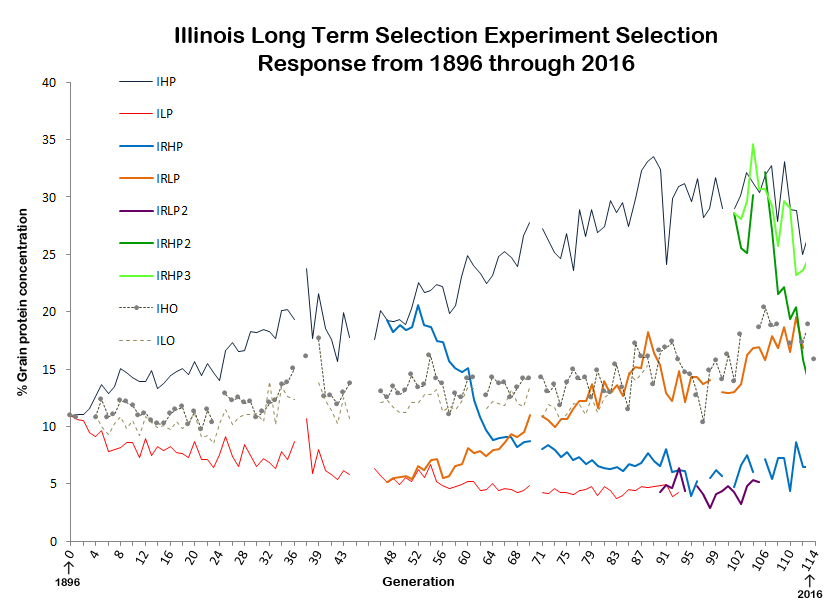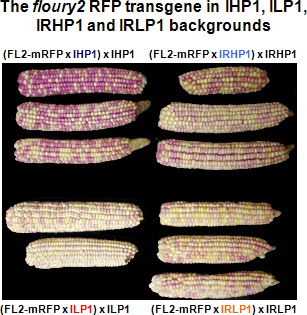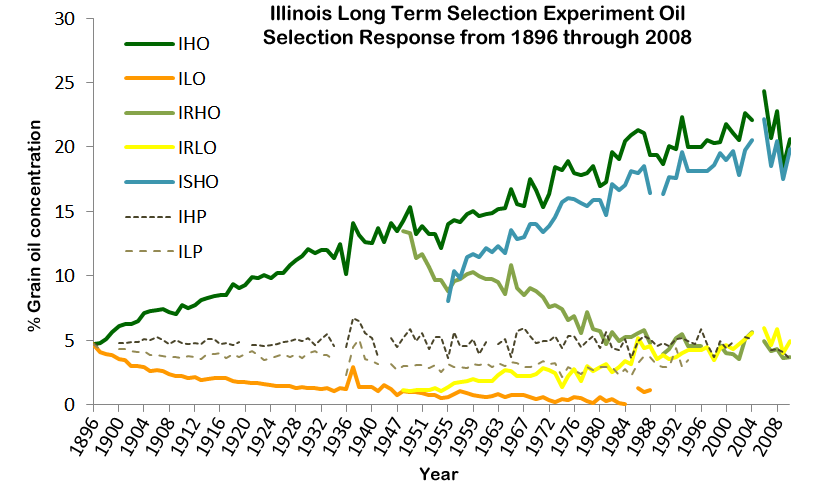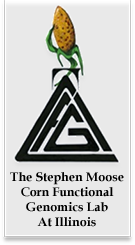Illinois Long-term Selection Experiment
Project Overview:
Our lab maintains this experiment, but our research focus is on the protein selections. Illinois High Protein (IHP) and Illinois Low Protein (ILP) represent the known extremes for protein concentrations in maize (see figure below). After forty-eight cycles of forward selection, breeders reversed the direction of selection by selecting low protein ears from IHP and high protein ears from ILP, thereby creating two new lines, Illinois Reverse High Protein (IRHP) and Illinois Reverse Low Protein (IRLP). Collectively, these four strains are referred to as the Illinois Protein Strains (IPS). The IPS provide a unique source of genetic material with which to make comparisons both between and among the strains and generations, at the DNA, mRNA, and protein levels, with a goal of elucidating the dynamics of evolutionary changes during these intervals. They are also a useful resource for discovering genes that contribute to seed protein accumulation, not only in maize, but other crop species.

Selection responses in the Illinois Protein Strains. Illinois High Oil (IHO) and Illinois Low Oil (ILO) are part of the same source population, but were not selected for protein. Thus, they illustrate the effects of random genetic drift. Selection for oil was dicontinued. IRHP: Illinois Reverse high protein; IRLP: Illinois Reverse low protein.
Selection for grain protein concentration in the IPS has specifically altered the concentration of the 19 and 22kD α-zein endosperm storage proteins, which constitute approximately 50% of total seed protein. A red fluorescent protein (mRFP1) transgene has been fused to the floury2 gene, encoding one of the 22kD class of α-zeins (Dr. Jackson’s lab, Cold Spring Harbor). This floury2 RFP transgene is a useful tool for investigating zein gene regulation, as illustrated by crossing to inbred lines derived from the IPS (IHP1, ILP1, IRHP1 and IRLP1). RFP expression shows the expected differences in color intensity, dark pink in IHP, light pink in ILP, and medium pink in IRHP and IRLP (see figure below).


While we have been focusing on the protein concentration trait, the story for oil is no less fascinating depending on your interest. The response to selection was also seen in the oil strains (see figure below) and the morphology of the corn plants and specifically their kernels changed quite drastically from the original population. The direction of selection was also reversed in the oil strains. These materials have been used in many studies and continue to be grown as a control for selection experiments.

Selection responses in the Illinois Oil Strains. Illinois High Oil (IHO) and Illinois Low Oil (ILO) are part of the same source population. Selection for oil was dicontinued in 2008. IRHO: Illinois Reverse high oil; IRLO: Illinois Reverse low oil.
Data:
A comprehensive compilation of data and publications related to the Illinois Long-term Selection Experiment is available at the University of Illinois Digital Environment for Access to Learning and Scholarship (IDEALS). To download an Excel spreadsheet containing data generated from the most recent cycle of the Illinois Long-term Selection Experiment, click here.Posters:
2004 2005 2007 2008 2009 2010People:
Han ZhaoChristine Lucas
Nicholas Heller
